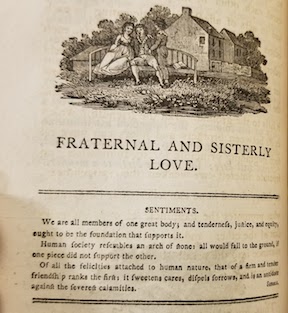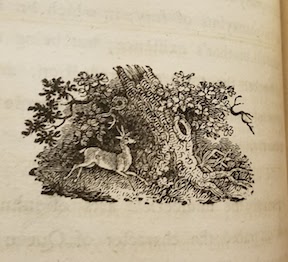
Mary Pilkington (1766-1839) provides young women with a variety of famous historical women to emulate and model as they develop into adults. She uses her text to guide women to "Moral Goodness" through her explanations of and connections to women and men from history.

Image 2. Opening page of "Fraternal and Sisterly Love" chapter.

Image 3. Final page of "Fraternal and Sisterly Love" chapter.
A Mirror for the Female Sex: Historical Beauties for Young Ladies. Intended to Lead the Female Mind to the Love and Practice of Moral Goodness. Designed Principally for the Use of Ladies' Schools, by Mary Pilkington (1798)
Pilkington was an English writer working in the 17th and 18th centuries, though little is known about her personal life aside from marrying the surgeon who look over her father's medical practice upon his death when Pilkington was 15. While her husband was away working as a naval surgeon, she worked as a governess.1 She wrote at least forty novels by 1825, most for children.
The seventeen chapters in A Mirror for the Female Sex cover topics from Filial Duties to Virtue to Passion and Anger. Each chapter begins with a short Bible passage, primarily from the book of Proverbs, a quote from the Greek philosopher Seneca, or an uncredited quote. The first pages of each chapter begin with an explanation of why the topic is important and her opinions of the topics. She goes on incorporate women ranging from Cleopatra to Queen Elizabeth I to the wives' of world leaders such as Alexander the Great and Julius Cesar. Although primarily relying on the lives and stories of famous women, she does incorporate stories of little known women, such as "The Wife of a Macedonian Soldier." In addition, she writes men such as Nero and Sir Thomas Moore as well using their stories to further detail her explanations.
The book features wood block engravings at the beginning and end of each chapter depicting. All the chapters begin with an engraving depicting a woman, in several she is alone while in others she is interacting with another person, usually a man (see image 2). The images relate in some way to the contents of the chapter, for example a beautiful woman laying on a bench while an angel kneels nearby. Greek and Roman influences can be seen in the some architecture shown, along with Biblical references through depictions of Angels. Some show simply daily life with houses and materials common to the time.
The engravings as the end of each chapter are slightly small and most often depict nature scenes (see image 3). At first, they appear to have a less direct connection to the chapter that has just concluded, but symbolic meaning related to the content. Several of these images show solitary figures and in contrast to the images at the beginning of each chapter, men are drawn with a referencing female character. From these lessons, images, and historical refences, young women are to learn the imporance of living a moral life through the trials and tribulations of those who have come before them. Pilkington wrote of her belief in educating some women, though not all, and the importance of that education for women’s moral strength.
Notes
1 "Mary Pilkington” Wikipedia, https://en.wikipedia.org/wiki/Mary_Pilkington. Access 2 March 2018.↩
This spotlight exhibit by Ms. French as part of Dr. Johanna Drucker's "History of the Book and Literacy Technologies" seminar in Winter 2018 in the Information Studies Department at UCLA.
For documentation on this project, personnel, technical information, see Documentation. For contact email: drucker AT gseis.ucla.edu.